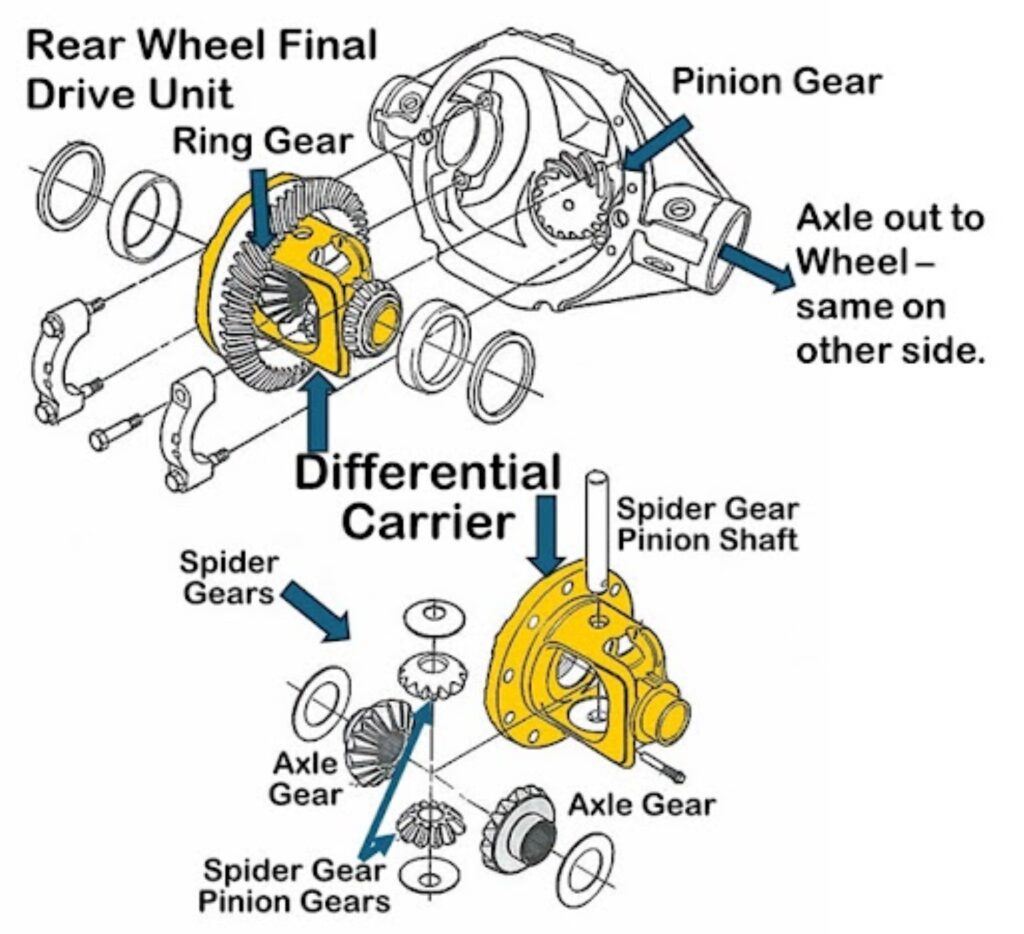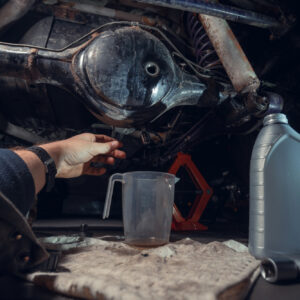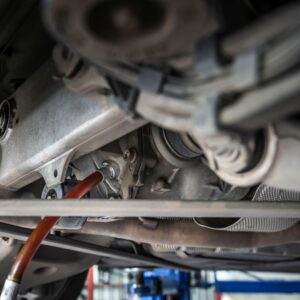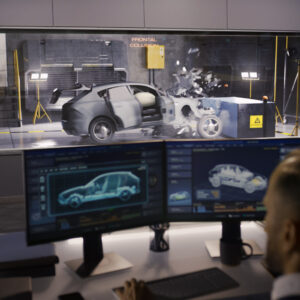You might have heard about the differential as a part of the vehicle’s drivetrain. If it fails, it can cause various issues, like tire damage, grease leaks, excessive vibrations, gear grinding, and poor handling. But what does this component do exactly?
What Is a Differential?
A differential is a part that divides the power from your driveshaft and split engine power to the two drive wheels.
Each drive axle will have a set of differential gears in the center of the ring gear carrier. The final drive consists of a ring gear, a pinion, and the small set of gears in the heart of the carrier, with one gear splined to each axle and two or more gears riding on a pinion shaft or shafts so that they interact with the axle gears.
Each drive axle will have a set of differential gears in the center of the ring gear carrier. The final drive consists of a ring gear, a pinion, and the small set of gears in the heart of the carrier, with one gear splined to each axle and two or more gears riding on a pinion shaft or shafts so that they interact with the axle gears.
–Anthony Harlin, ASE Certified Master Automobile Technician
Why Vehicles Need a Differential
If you trace the path that wheels take when a vehicle is turning, you’ll see that the outside wheel will travel a further distance and the inside wheel will travel less.
Turning will be difficult for vehicles without a differential that can split engine power and allow the two drive wheels to spin independently. If wheels are locked to spin at the same speed, the tires would need to slip for the vehicle to turn.
Turning a locked differential vehicle takes a lot of force. The wheels can lose grip and slip. At the same time, it creates a lot of stress on the suspension and tires.

How Does a Differential Work?
To understand how a differential gear works, you must know the functions of its main components.
- Pinion Gears – This small gear is mounted at the end of the driveshaft. It spins the ring gear.
- Ring Gear – This large gear receives the rotational force from the driveshaft and engine. It’s typically mounted over one of the axles. When it spins, it carries with it the differential housing and spider gears.
- Differential Housing – When the ring gear spins, the differential housing also spins, which is where the spider gear is mounted.
- Spider Gear – This gear is attached to the ring gear and rotates with it. The spider gear meshes with the axle gears.
- Axle Gears – These gears are splined onto the axles that lead to each drive wheel.
The differential gears (spider gears in the ring gear carrier housing) allows the wheels to spin at different speeds when necessary. This is particularly important when the vehicle is cornering because the outside wheels need to rotate more than those inside.
The pinion gear is driven by the transmission and it drives the ring gear, which provides gear reduction. This means the pinion gear that inputs power to the final drive ring gear spins (on average) about 3 times as fast as the ring gear that drives the axles.
The spider gears that provide differential action are spinning together when the vehicle is going straight and don’t rotate against each other unless the vehicle is making a turn.
Rear-wheel drive final drive assemblies with their differentials are typically located where the driveshaft intersects with the axles. In a front-wheel-drive vehicle, the final drive gears will be helical cut rather than hypoid gears and will be part of the transaxle, but will still have the small differential gears like a rear-wheel final drive unit.
What Are Locking Differentials?
Locking differentials lock the left and right axles together, which keeps both wheels spinning at the same speed. Some four-wheel drive vehicles that are meant to be driven over loose or uneven terrain have locking differentials.
For example, one wheel could be on loose gravel, while the other is on solid rock. The wheel in contact with the solid surface can create too much resistance. As a result, the differential will send all the power to the wheel with less traction, causing it to spin. This can get the vehicle stuck because the wheel with the most traction isn’t getting enough power.
How Does a Locking Differential Work?
A locking differential can spin both axles at the same using a dog gear located between the two sun gears leading to both axles. This dog gear is typically disengaged when the differential isn’t locked. When the differential is locked, these dog gears are engaged, meshing the two axles together and spinning both axles at the same rate.
What Are Limited Slip Differentials?
There are limited slip differentials that have clutches and plates stacked between the axle gears and the differential carrier and a large strong spring or springs forcing them out against those clutches, which allow for slippage during turns but prevent one wheel from spinning due to differential action in low traction situations like wet grass, mud, or snow. These differentials require a special additive to prevent the clutches from chattering during turns.
How Do Limited Slip Differentials Work?
There are different types of limited slip differentials. One type used in sports cars utilizes a clutch between the two axles. When one wheel loses grip, a clutch pack that connects both axles allows both wheels to have some slip, but power will still reach both wheels. Other limited slip differentials might utilize hydrodynamic friction from fluids rather than surface friction between clutch discs.
Any information provided on this Website is for informational purposes only and is not intended to replace consultation with a professional mechanic. The accuracy and timeliness of the information may change from the time of publication.

































